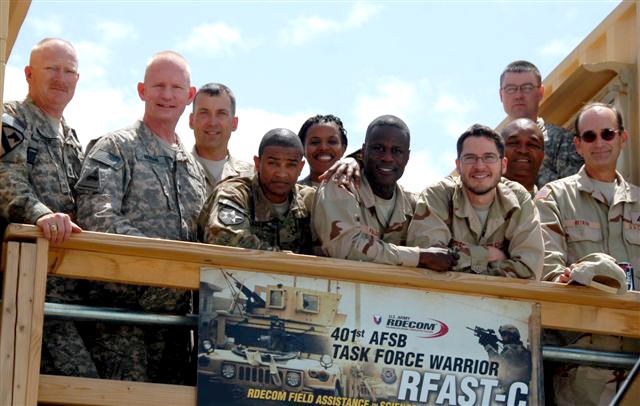ABERDEEN PROVING GROUND, Md. - Motivated by its motto to "empower, unburden and protect the American Warfighter," the U.S. Army Research, Development and Engineering Command is now delivering real-time science and technology support directly to Warfighters on the battlefield.
Task Force Warrior, led by a three-person team that deployed in late January, has evolved into the RDECOM Field Assistance in Science and Technology Center at Bagram Air Base, Afghanistan, according to Army officials here.
Incremental but necessary steps to house and support the RFAST-C are on track, according to Lt. Col. Duane Amsler, RDECOM FAST deputy director.
"The team is on the ground, and we are moving forward," he said.
Lt. Col. Yolanda Frazier, from the RDECOM headquarters staff, led the team's deployment, aided by Sgt. Maj. William Tager from Army Materiel Systems Analysis Activity, and civilian executive officer Mark Oetken from the Armament Research, Development and Engineering Center, Picatinny, N.J.
Three engineers and an operations noncommissioned officer have since joined the team. Engineer Scott Smith is from the Tank Automotive Research, Development and Engineering Center in Warren, Mich.; Bernie Rice is from the Armament Research, Development and Engineering Center at Picatinny, N.J.; and Michael Fields is from Communications-Electronics Research, Development and Engineering Center (Night Vision) at Fort Belvoir, Va. Operations NCO Sgt. John Malloy was the latest to arrive from Natick Soldier Research, Development and Engineering Center, Natick, Mass.
The team's initial focus was to establish an engineering "smart cell" and build collaboration with other deployed elements across the materiel enterprise community to speed the delivery of new technologies and capabilities to the Soldier.
Partners in RFAST-C's efforts include: deployed elements of Assistant Secretary of the Army for Acquisition, Logistics, and Technology; program executive officers and program managers; Army Test and Evaluation Command; U.S. Army Training and Doctrine Command; the Rapid Equipping Force; and the Assistant Secretary of Defense for Research and Engineering.
Describing RFAST-C as "the smart cell on the ground to enhance RFI (request for information) processing," Amsler said the task force has secured appropriate work space and attained initial operational capability, the second of four planned phases to establish the center at Bagram.
Amsler said several challenges face the team.
"The location that's been identified as the manufacturing floor is currently being used by another organization. We're still a number of days out from being able to populate it with equipment, so we have time. The equipment is on order and scheduled to arrive in the August/September timeframe," he said.
"Now we're working on the IT (information technology) infrastructure, and there are some challenges there. We're working on the computer assisted design (CAD) equipment and getting the servers up and running," he explained.
RFAST-C aims to become the Army's command center for science and technology activity for Operation Enduring Freedom. The center can support up to a 32-person team, but Amsler said that number is misleading.
"The facility is designed to be able to grow to 24/7 operations, but initially it will be single shift. A staff of 32 is the end state if we go with a full-blown prototype integration facility. The mission analysis to make that decision is now being done," he said.
Amsler said the center's initial impact would dramatically change the way engineering solutions are delivered to the Warfighter.
"In the current RFI process, we're engaging five people over two weeks [with a question] that can be answered with a phone call if you know the right people," he said.
"So the first impact is to bring those people together so we can answer the question as close as we can to where it's coming from without having to process all the way through to the rear and back.
"I use the analogy 'panning for gold,'" Amsler said. "We're looking for that thing we can get our hands on and say, 'This is a great cross-command integration project that we can use to get something out very quickly,' or inform our science and technology development programs going forward to plug into.
"The fundamental challenge," Amsler continued, "is it needs to be an enterprise-level system. We need one system that everybody is a part of - from the PM community, to PEO communities under ASA (AL&T), to TRADOC, to the rest of Army Materiel Command. A lot of stuff is part numbers and supply issues, and that's the life cycle management commands or the Army Sustainment Command."
"My vision at RFAST-C is to create a pilot program and bring those entities together in an area where they have a sense of urgency - on the ground forward with the guys. It's the right place to get that collaboration going and demonstrate that we can make it work. And if we can make it work there, then we bring it back and try to institutionalize it at the global level.
"This is a model for the next war," Amsler added. "Whether we wind down in the next year in Afghanistan, we're going to be someplace again. We're going to have technology challenges again.
"That's where we see ourselves going," he said.


Social Sharing